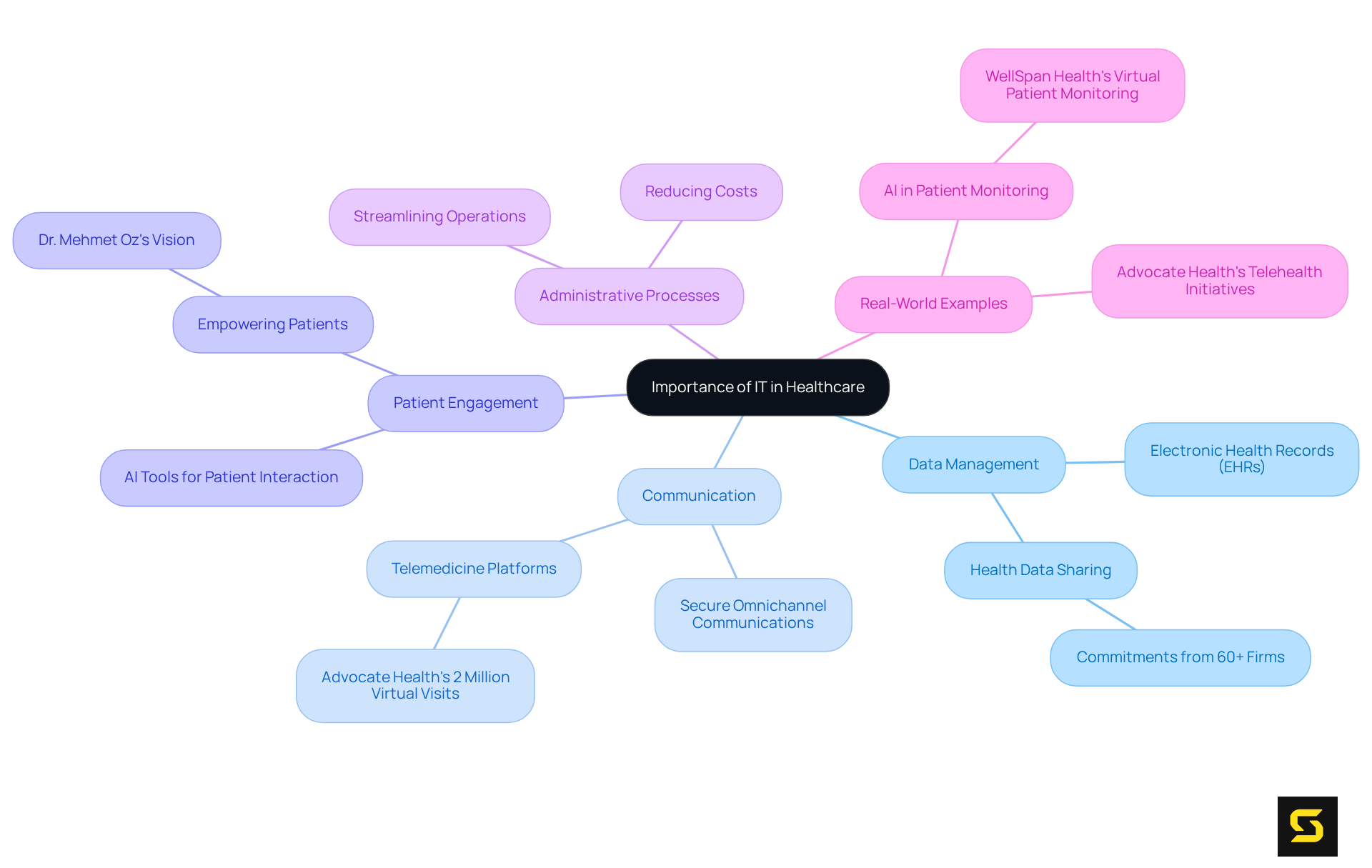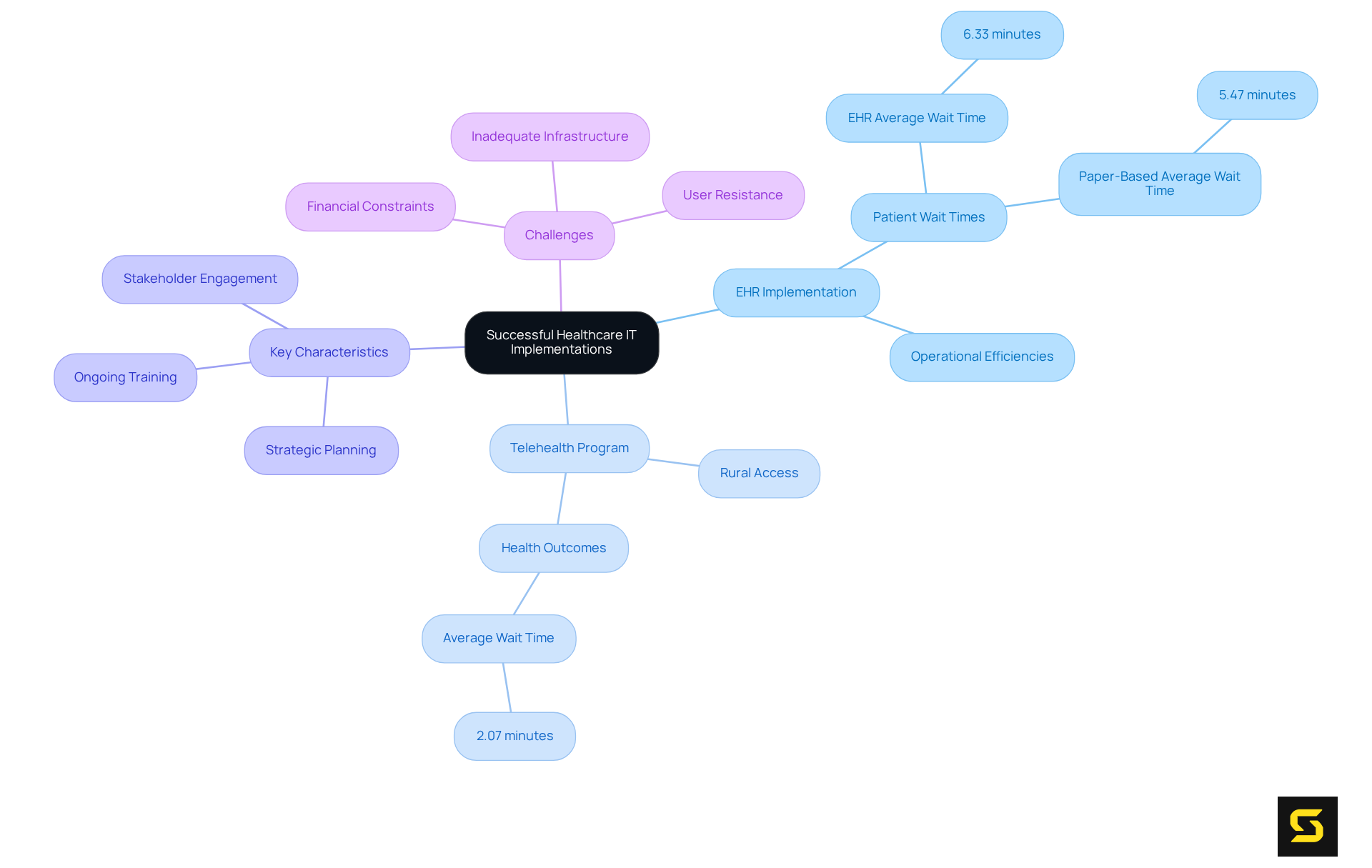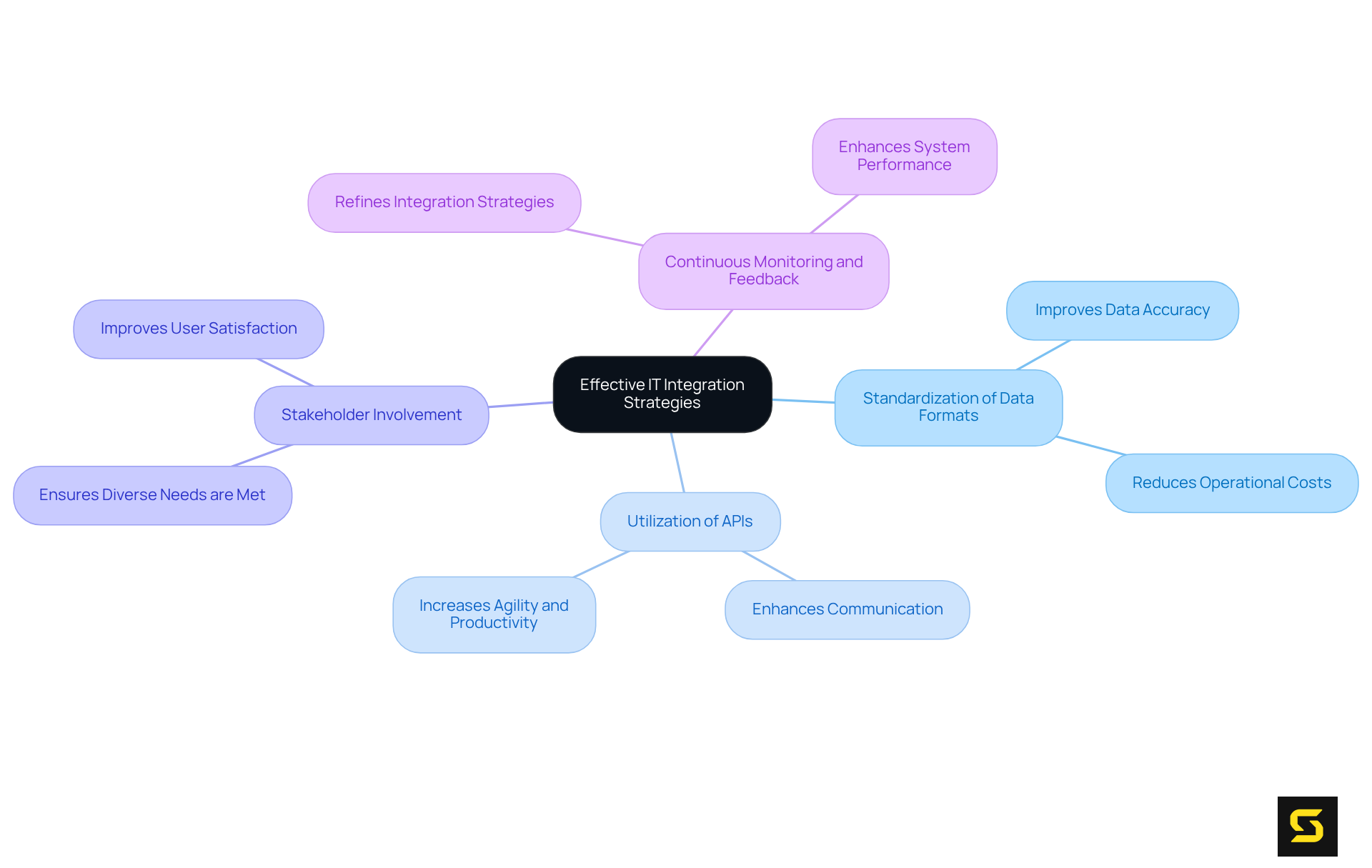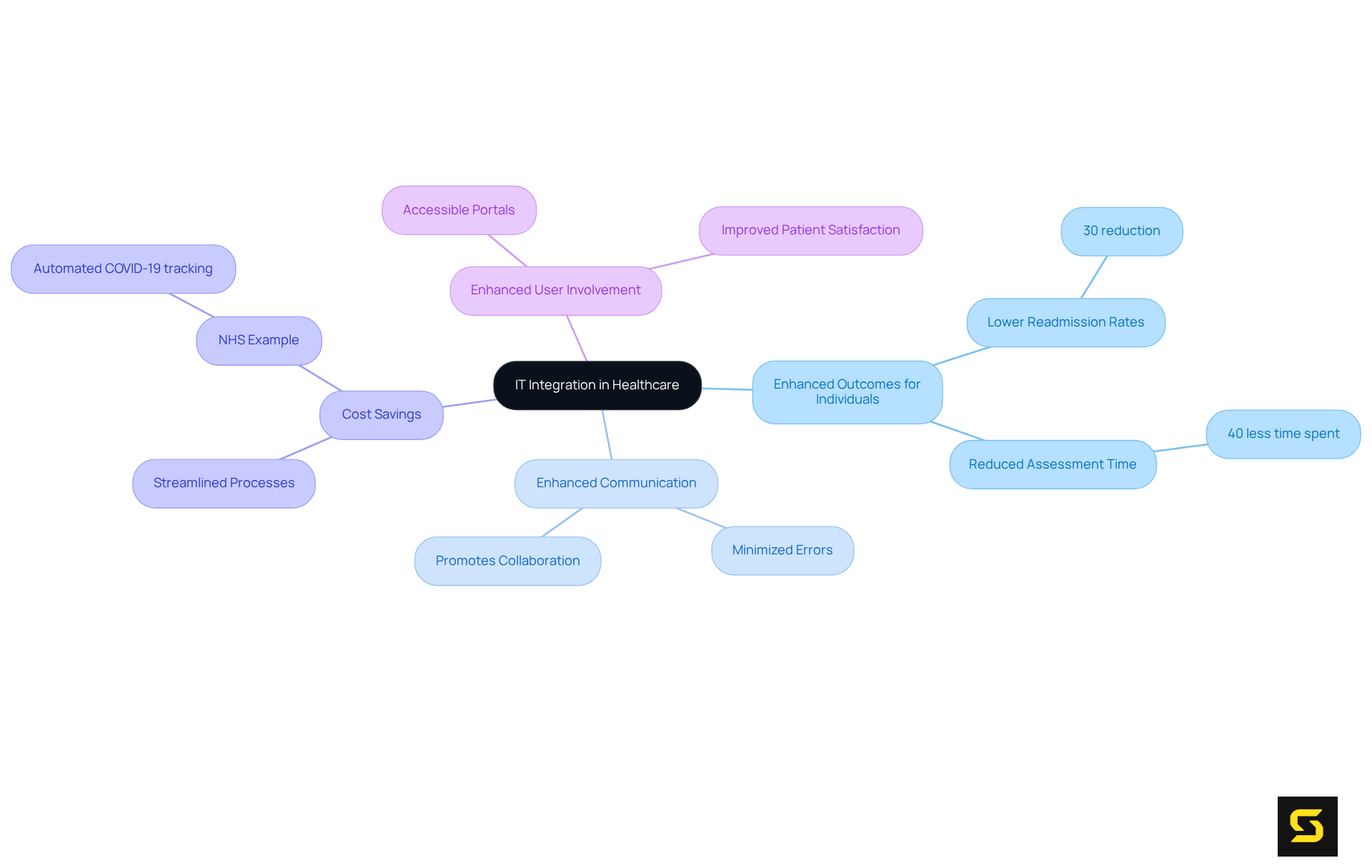Overview
This article presents proven strategies for attaining success in Software as a Service (SaaS) within the healthcare sector, underscoring the pivotal role of IT integration in enhancing patient care and operational efficiency. Successful implementations, such as electronic health records and telehealth programs, exemplify how:
- Strategic planning
- Stakeholder involvement
- Continuous evaluation
are vital for optimizing healthcare IT solutions and improving health outcomes. By adopting these strategies, healthcare organizations can effectively leverage technology to transform their operations and elevate patient care.
Introduction
In the dynamic realm of healthcare, the integration of information technology (IT) is not merely a trend; it is a necessity that shapes the future of medical services. As organizations strive to enhance patient care and operational efficiency, understanding the pivotal role of IT becomes crucial. However, the journey to successful IT implementation is fraught with challenges and complexities.
How can healthcare providers navigate these hurdles to harness the full potential of technology and ultimately improve patient outcomes?
Recognize the Importance of IT in Healthcare
In the evolving landscape of medical services, the integration of IT solutions is essential for it in healthcare. Technology profoundly enhances it in healthcare by optimizing data management, streamlining communication among providers, and fostering patient engagement. For instance, electronic health records (EHRs) enable seamless access to medical information, facilitating informed decision-making and improving treatment outcomes. Additionally, IT solutions simplify administrative processes, showcasing how it in healthcare reduces costs and allows for a reallocation of resources towards direct patient care. It is crucial to recognize that investing in it in healthcare equates to investing in the future of medical services, where efficiency and quality of care are paramount.
Real-world implementations highlight this transformation. Hospitals that have adopted telemedicine platforms, such as Advocate Health, which reports approximately 2 million virtual visits annually, exemplify how technology enhances access and convenience for patients, allowing them to receive care remotely. These advancements not only elevate patient experiences but also underscore the necessity for medical organizations to prioritize it in healthcare as part of their strategic planning. By 2025, over 60 health and technology firms have committed to improving health data sharing, reflecting a collective effort toward a more interconnected and effective medical infrastructure. This transition is further bolstered by the anticipated growth of AI tools, which are expected to enhance documentation, communication, and automation, ultimately alleviating the burden on medical professionals and improving patient outcomes. Dr. Mehmet Oz, CMS Administrator, articulated this sentiment, stating, "For too long, individuals in this country have been weighed down by a medical framework that has not evolved alongside the disruptive innovations that have changed nearly every other sector of our economy.

Explore Successful Healthcare IT Implementations
Successful healthcare IT implementations exhibit key characteristics that significantly enhance it in healthcare. A notable instance is the implementation of a comprehensive electronic health record (EHR) network across a large hospital chain, resulting in an impressive 30% decrease in patient wait times. Average waiting durations were recorded at 6.33 minutes for EHR solutions compared to 5.47 minutes for paper-based alternatives. This achievement stemmed from meticulous planning, active stakeholder engagement, and ongoing staff training, ensuring that all users were well-equipped to utilize the new system effectively.
Another significant example is a telehealth program introduced by a local healthcare provider, focused on enhancing access to services for rural communities. By utilizing cloud-based solutions, the provider effectively linked individuals with specialists remotely, resulting in improved health outcomes for underserved populations. Notably, individuals in rural regions experienced an average waiting duration of merely 2.07 minutes, demonstrating the initiative's positive impact on access to care. These instances underscore the critical importance of strategic planning, thorough user training, and ongoing evaluation in achieving successful IT implementations, especially regarding it in healthcare.
Statistics indicate that medical frameworks that effectively integrate EHRs can experience enhanced operational efficiencies, making it in healthcare more effective. Studies reveal that average waiting times can decrease significantly, thereby improving overall patient experiences. Furthermore, expert viewpoints consistently emphasize that the efficacy of EHR platforms is closely tied to their incorporation into clinical workflows, stressing the necessity for customized solutions that address the specific requirements of healthcare providers. However, challenges such as financial constraints and inadequate infrastructure remain critical factors that can hinder successful EHR implementation, as evidenced by the negative correlation between financial support and governmental assistance. Addressing these challenges is essential for optimizing the advantages of EHR technology.

Implement Effective IT Integration Strategies
To execute efficient IT integration strategies, organizations must begin with a comprehensive evaluation of their existing frameworks to identify any gaps. A phased approach proves advantageous, facilitating gradual integration that minimizes disruption. Key strategies include:
- Standardization of Data Formats: Ensuring that all platforms utilize compatible data formats is crucial for facilitating smoother data exchange and enhancing interoperability. This standardization is not merely beneficial; medical organizations that have adopted standardized data formats report enhanced data accuracy and reduced operational costs when applying it in healthcare.
- Utilization of APIs: Application Programming Interfaces (APIs) empower various platforms to communicate effectively, enabling real-time data sharing. Organizations leveraging APIs have experienced significant improvements in operational efficiency, with 54% of IT leaders acknowledging increased agility and productivity.
- Stakeholder Involvement: Engaging both technical teams and end-users in the integration process is essential to ensure that solutions meet the diverse needs of all parties involved. Successful medical IT projects often emphasize the importance of teamwork, resulting in greater user satisfaction and improved adoption rates.
- Continuous Monitoring and Feedback: Establishing metrics for success and regularly soliciting feedback enables organizations to refine their integration strategies over time. Ongoing enhancement methods have proven effective in improving system performance and user experience, ultimately demonstrating how it in healthcare can lead to better health outcomes.
By implementing these strategies, medical organizations can cultivate a cohesive IT environment that enhances operational efficiency and significantly elevates service quality, particularly when focusing on it in healthcare.

Leverage Benefits of IT Integration for Enhanced Care
The incorporation of it in healthcare presents numerous advantages that significantly enhance care for individuals and improve operational efficiency. Among these key advantages are:
-
Enhanced Outcomes for Individuals: Integrated systems facilitate comprehensive access to individual data, empowering healthcare providers to make informed decisions swiftly. For instance, the digital healthcare platform Huma has been shown to lower readmission rates by 30% and reduce the time spent assessing individuals by up to 40%. Such efficiencies not only lead to improved treatment outcomes but also contribute to overall individual health.
-
Enhanced Communication: IT integration fosters seamless communication among medical teams, minimizing errors and promoting collaboration. This aspect is crucial in environments where prompt information exchange can directly impact individual safety and the quality of care.
-
Cost Savings: Streamlined processes and reduced redundancies can result in substantial cost savings for medical organizations. A notable example is the NHS Aneurin Bevan Health Board, which automated data linking to enhance COVID-19 vaccination tracking, leading to significant operational efficiencies.
-
Enhanced User Involvement: Technology empowers individuals to take an active role in their medical care through accessible portals and mobile applications. This engagement not only boosts patient satisfaction but also improves adherence to treatment plans, as patients feel more connected to their care.
By harnessing these benefits, healthcare organizations can elevate their service delivery and position themselves as leaders in a rapidly evolving industry, effectively addressing the challenges posed by modern healthcare demands and integrating it in healthcare.

Conclusion
The integration of IT solutions in healthcare represents not merely a trend but a fundamental shift reshaping the industry. By acknowledging the critical role technology plays in enhancing patient care, streamlining operations, and improving communication, healthcare organizations can strategically position themselves for success in an increasingly digital landscape. Investing in IT is not just an expense; it is an investment in a future where quality and efficiency reign supreme.
Throughout this article, various successful implementations underscore how strategic planning, user engagement, and effective integration can yield significant improvements in healthcare delivery. Consider the adoption of electronic health records that reduce wait times, or telehealth programs that enhance access for rural communities. The evidence is irrefutable: well-executed IT integration results in better patient outcomes and operational efficiencies. Furthermore, the advantages of enhanced communication, cost savings, and increased patient involvement highlight the transformative power of IT in healthcare.
As the healthcare sector continues to evolve, embracing these technologies is imperative for organizations aspiring to thrive in a competitive environment. Stakeholders must prioritize IT integration strategies to navigate challenges and capitalize on the myriad benefits that accompany it. By doing so, healthcare providers can not only enhance their service delivery but also ensure they remain at the forefront of innovation, ultimately paving the way for a healthier future for all.
Frequently Asked Questions
Why is IT important in healthcare?
IT is essential in healthcare as it optimizes data management, streamlines communication among providers, and fosters patient engagement, ultimately enhancing the quality of medical services.
How do electronic health records (EHRs) benefit healthcare?
EHRs enable seamless access to medical information, facilitating informed decision-making and improving treatment outcomes.
What impact does IT have on administrative processes in healthcare?
IT simplifies administrative processes, reducing costs and allowing for a reallocation of resources towards direct patient care.
What is the significance of investing in IT for healthcare?
Investing in IT equates to investing in the future of medical services, where efficiency and quality of care are paramount.
Can you provide an example of IT implementation in healthcare?
Advocate Health, which reports approximately 2 million virtual visits annually, exemplifies how telemedicine platforms enhance access and convenience for patients, allowing them to receive care remotely.
How are health and technology firms planning to improve healthcare by 2025?
Over 60 health and technology firms have committed to improving health data sharing, reflecting a collective effort toward a more interconnected and effective medical infrastructure.
What role will AI tools play in the future of healthcare?
AI tools are expected to enhance documentation, communication, and automation, alleviating the burden on medical professionals and improving patient outcomes.
What did Dr. Mehmet Oz say regarding the evolution of the medical framework?
Dr. Mehmet Oz stated that individuals have been weighed down by a medical framework that has not evolved alongside disruptive innovations affecting other sectors of the economy.





